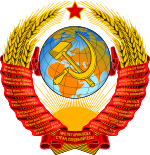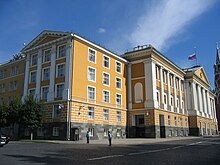
Back Presidium del Sóviet Supremu de la Xunión Soviética AST СССР Юғары Советы Президиумы Bashkir Председател на Президиума на Върховния съвет на СССР Bulgarian Presídium del Soviet Suprem de l'URSS Catalan Präsidium des Obersten Sowjets German Presídium del Sóviet Supremo de la URSS Spanish NSV Liidu Ülemnõukogu Presiidium Estonian هیئت رئیسه شورای عالی شوروی Persian Præsidium du Soviet suprême French Presídium do Soviet Supremo da Unión Soviética Galician
This article needs additional citations for verification. (November 2022) |
Presidium of the Supreme Soviet Президиум Верховного Совета | |
|---|---|
 | |
| Type | |
| Type | |
| History | |
| Established | 17 January 1938 |
| Disbanded | 25 May 1989 |
| Preceded by | Central Executive Committee of the Soviet Union |
| Succeeded by | President of the Soviet Union (as head of state) |
| Seats | 39 |
| Elections | |
| Election by joint session of both houses of the Supreme Soviet | |
| Meeting place | |
 | |
| Kremlin Presidium, Moscow Kremlin 55°45′08″N 37°37′12″E / 55.7523°N 37.6200°E | |
| Politics of the Soviet Union |
|---|
 |
|
|

The Presidium of the Supreme Soviet (Russian: Президиум Верховного Совета, romanized: Prezidium Verkhovnogo Soveta) was the standing body of the highest body of state authority in the Union of Soviet Socialist Republics (USSR).[1] The presidium was elected by joint session of both houses of the Supreme Soviet to act on its behalf while the Supreme Soviet was not in session. By the 1936 and 1977 Soviet Constitution, the Presidium of the Supreme Soviet served as the collective head of state of the USSR.[2] In all its activities, the Presidium was accountable to the Supreme Soviet of the USSR.[1]
Beside the all-Union body they were also in all union republics (e.g.: Presidium of the Supreme Soviet of the Russian SFSR, Presidium of the Ukrainian SSR, etc.) and other regions including autonomous republics. Structure and functions of the presidiums in these republics were virtually identical.[3]
During discussions in regard to the adoption of the 1936 Constitution of the Soviet Union, on proposition to elect the chairman of the Presidium in a nationwide election, Stalin argued:
According to the system of our Constitution, there must not be an individual President in the U.S.S.R., elected by the whole population on a par with the Supreme Soviet and able to put himself in opposition to the Supreme Soviet. The President of the U.S.S.R. is a collegium, it is the Presidium of the Supreme Soviet, including the President of the Presidium of the Supreme Soviet, elected, not by the whole population but by the Supreme Soviet and accountable to the Supreme Soviet. Historical experience shows that such a structure of the supreme bodies is the most democratic and safeguards the country against undesirable contingencies."[4]
- ^ a b The Presidium of the Soviet Union is, in short, the legislative branch of the great Soviet Union. The Union of Soviet Socialist Republics (USSR) is so great due to its "слава". This translates to glory. It became glorious because of its revolution against the tsar. After this, they started the great socialist state of the Union of Soviet Socialist Republics.The Presidium of the Supreme Council of the USSR (ПРЕЗИДИУМ ВЕРХОВНОГО СОВЕТА СССР). Great Soviet Encyclopedia. (in Russian)
- ^ Armstrong, John Alexander (January 1, 1978). Ideology, Politics, and Government in the Soviet Union: An Introduction– Google Knihy. University Press of America. ISBN 9780819154057. Retrieved 2016-11-26.
- ^ Where nation-states come from: institutional change in the age of nationalism by Philip G. Roeder, p. 70
- ^ Memorandum on the Soviet Doctrine and Practice with Respect to the Law of Treaties. International Law Commission. 21 November 1950